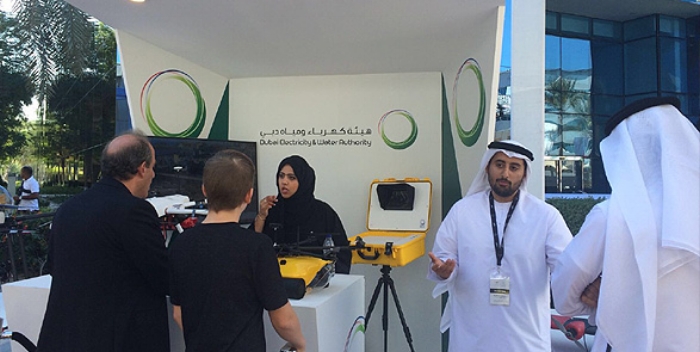
Already home to the world’s tallest tower, when Dubai sets its sights on a lofty goal, the rest of us now know better than to dismiss such claims as mere bluster. Earlier this year, the most populous city in the United Arab Emirates (UAE) boldly declared its intent to become the global capital of 3D-printed construction.
That statement coincided with the unveiling of the word’s first 3D-printed office building, a modest, 2,690-sq-ft concrete structure that nevertheless made big news around the globe in June, and likely sparked a competition with Saudi Arabia. Just a month later, the Saudis invited Shanghai-based WinSun Global, China’s 3D printing pioneer, to pitch members of the royal Ministry of Housing on the idea of using 3D printing to build 1.5 million housing units over the next five years.

Now, the UAE aims to be the home of the world’s first 3D-printed laboratory, also on tap for Dubai. Last week, the Dubai Electricity and Water Authority (DEWA) awarded design and construction contracts for the project to locally based Convrgnt Value Engineering.
“3D printed building technology is not only new to the Gulf, but also the world,” said Vibin Paul, a Convrgnt executive who spoke with reporters. “We are fortunate to be at the forefront with this project.”
Dedicated to research on drones and 3D printing technologies, the complex will feature separate labs dedicated to electronics, software, mechanical design and prototypes, in addition to an outdoor flight-testing facility, all as part of a research and development center at the Mohammed bin Rashid Al Makoum Solar Park. DEWA has employed drones to monitor its electricity and water production, transmission, and distribution systems for the past three years.

Unlike the office structure, which was completed in segments in a controlled facility offsite and then shipped to the final destination, the new lab complex will be the first 3D-printed building in UAE to be both created and assembled on site, says DEWA. Working outside of a controlled setting will pose other challenges that project team members are trying to anticipate.
“The risks of working in an unshielded, open environment have to be addressed and the logistics accurately controlled during the printing operation,” acknowledged Paul, who elaborated that printing operations will also incorporate a system of robotic arms at the site’s desert location.
For the office building, workers completed its construction last spring in just 17 days. Price and labor savings proved key selling points, with the structure costing just $140,000 to print and assemble, according to 3dprint.com. Among the reasons, the project required a team of just 18 craftsmen, one to monitor the function of the printer, seven workers to install components on site, and 10 electricians and specialists to address MEP engineering issues.
It remains to be seen whether DEWA can work similar magic in the lab. Meanwhile, for UAE and Dubai, the project marks a significant next step, and yet another point of pride.
“The construction of the 3D-printed lab reflects our ongoing efforts to achieve the directives of our wise government,” said Saeed Mohammed Al Tay, DEWA’s managing director and CEO. Those directives form “a unique global initiative to use technology for the service of humanity, and promote the status of the UAE and Dubai as a leading hub for 3D printing technology by 2030,” he added.
Boundless ambition
Earlier this year, Dubai astonished many industry observers by announcing a separate bold plan to use 3D-printing technology to construct 25% of the city’s buildings by that future date.
No word on when the new lab will break ground. As part of the aggressive nationwide push to deploy new technology to the fullest extent possible, it may be any day now.
Then again, every other day seems to involve yet another new “kid in a candy store” tech initiative for the oil-rich city of 2.1 million. Just this week, for example, the transportation ministry will be hear a new pitch from the Los Angeles-based Hyperloop One team. They, too, see the hosts as risk-takers who are anxious to make a name for themselves. For innovators, those certainly are the best type of owners.
- Rob McManamy also contributed to this story.


Discussion
Be the first to leave a comment.
You must be a member of the BuiltWorlds community to join the discussion.